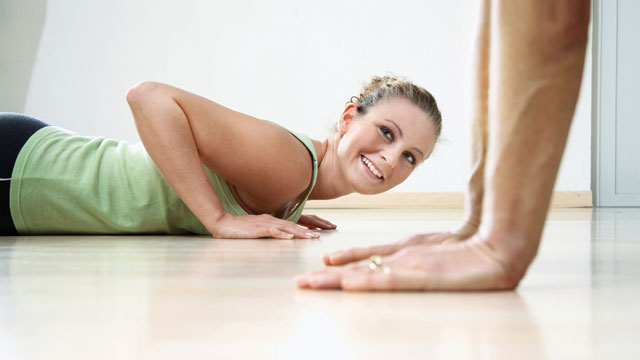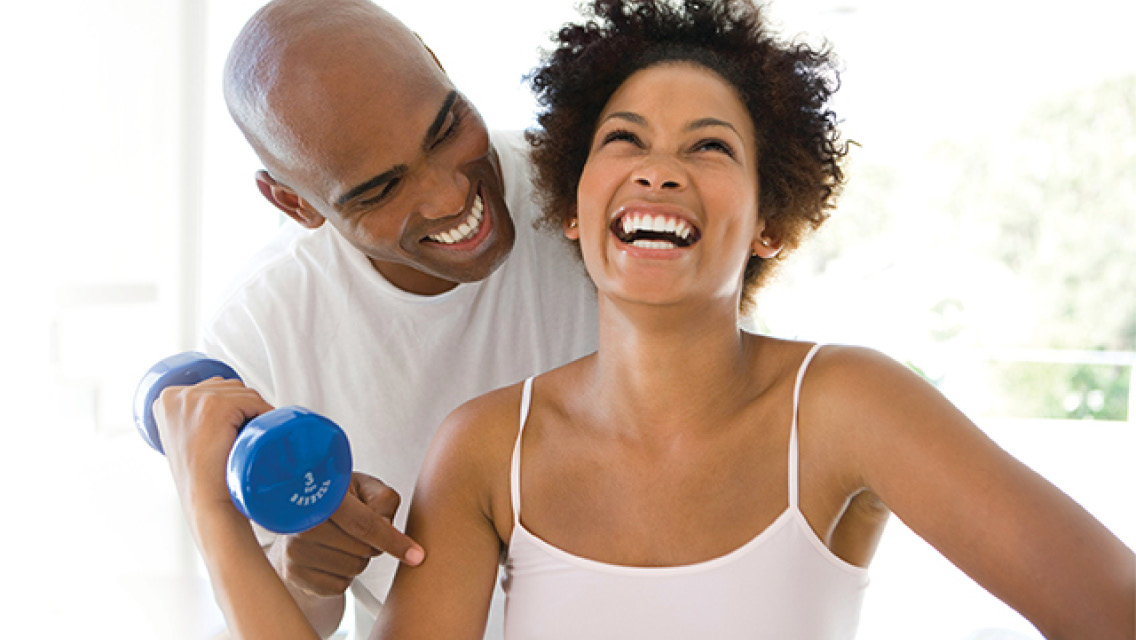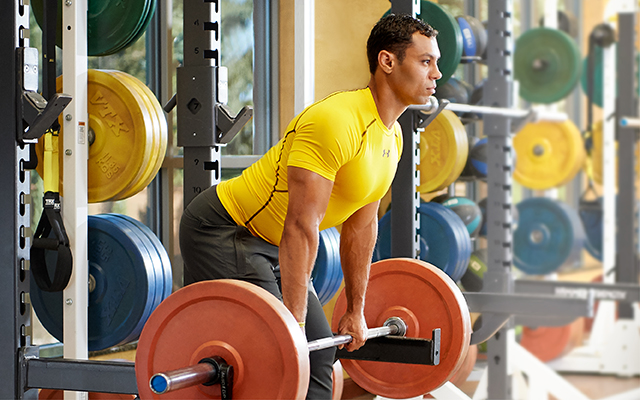Confidence ⋅ Heart ⋅ Circulation ⋅ Mitochondria ⋅ Muscle ⋅ Pain ⋅ Endorphins ⋅ Mental Health ⋅ Nutrition
You’ll remember this from grade school: An object at rest tends to stay at rest, while an object in motion tends to stay in motion. It’s Newton’s First Law. In fitness terms, this means that the more you exercise, the more your body wants to exercise.
“Our bodies were created to move,” says Sally Edwards, MS, founder of Heart Zones training company in Sacramento, Calif., and author of The Heart Rate Monitor Guidebook to Heart Zone Training. “When you don’t move, you’re violating the principles of physiology.”
Part of it is a state of mind, of course. When you stick with a routine for more than a few weeks, working out becomes a habit. And as you begin to see results, your self-confidence and motivation build, making it easier to keep moving day after day. But there are also plenty of physical changes that contribute to the cumulative it-gets-easier effect. Your heart pumps more efficiently. Your circulation improves. Your muscles take longer to fatigue. Your body may get lighter, more compact and easier to move through space.
“These are tangible rewards that can propel you forward in your fitness, making it harder to revert to your former sedentary self,” says Rachel Cosgrove, Santa Clarita, Calif.–based trainer and author of The Female Body Breakthrough.
Pay attention to those payoffs, and before long you’ll find it tougher not to exercise. Here are nine motivating ways that your body conspires to help you keep getting stronger and fitter by the day.
#1: Boosted Confidence
Self-confidence comes as the result of believing you can accomplish the things you set out to do. And from the day you begin an exercise routine, you’re proving to yourself you can do just that. Each challenge you overcome results in an influx of feel-good thoughts and emotions.
“As people start an exercise program, they may have a number of negative associations,” Cosgrove explains. “You may be telling yourself, ‘I don’t have time for this’ or ‘This isn’t my idea of fun.’ But then, after you work out, you feel a sense of accomplishment. You realize you can do it. You may notice you sleep better that night and wake up with more energy the next day.” Over time, as you successfully complete more workouts, those positive associations begin to outweigh the negative ones, and your confidence skyrockets.
This was certainly true for Ronnie Martin, 55, of Atlanta, Ga. Martin wanted to lose 15 pounds and regain the energy she felt in her 20s and 30s. Yet, overcoming her negative associations with exercise was tough at first, she recalls. “It took me a while to internalize the desire to work out,” she says. “As I drove to the gym, I’d be thinking, ‘I don’t want to do this.’ Yet, once I arrived, it was fine.”
Martin used the gym’s computerized system to track her progress — and supply motivation. “My gym posts a list of the top 10 exercisers based on frequency, duration and intensity of workouts each month, and my goal was always to be on that list,” she says. She quickly made the list and noticed her energy rebounding and her self-esteem improving. “I reached my goal weight, and I’m finally at a point where I’m comfortable with my body,” she explains. “I no longer try to hide under big clothes. I’m even comfortable wearing sleeveless shirts — it’s been a very long time since I did that.”
Research suggests that this boost in self-confidence is not just a result of improved body image, though. A 1997 study published in the Journal of Behavioral Medicine followed middle-aged men on a walking program over the course of five months. As their aerobic capacity grew, the participants also gained significant increases to their “physical esteem.”
A more recent study conducted in Great Britain showed that people who began a regular exercise program had higher self-worth and a more positive outlook toward their overall health compared with people who stayed home. These positive changes happened immediately, before the subjects saw physical changes in their bodies.
#2: Stronger Heart
Just as your leg and arm muscles get stronger with exercise, your heart muscle also tones up, becoming far more efficient. “With exercise, the tensile strength, or contractability, of the heart develops,” notes Edwards. In other words, it takes fewer heartbeats to pump the same amount of blood through your body. This not only allows you to exercise with less effort, “it also increases your longevity, since your heart won’t have to work as hard over your lifetime,” Edwards explains. The best part is, this change happens rapidly once you start a regular exercise routine.
Want proof? An easy, tangible way to measure heart strength is to wear a heart-rate monitor while exercising. Edwards suggests this simple test:
Walk or jog a set distance (say, a mile on a track or treadmill). Select a heart-rate number between 120 and 140 beats per minute (bpm) and hold that number throughout the walk or run, and time how long it takes to finish the mile. “Let’s say the first time you run a mile, it takes you 18 minutes,” Edwards says. “Repeat that workout once per week — one mile at 130 bpm. After a few weeks, you’ll notice it takes less and less time to complete that mile.” That’s because your heart is pumping stronger and more efficiently than in previous weeks. As you exercise more often, you’ll notice your resting heart rate decreases as well, indicating a stronger heart muscle. “This is a much better way to measure your progress than getting on a bathroom scale,” Edwards says.
#3: Improved Circulation
Capillaries are the smallest blood vessels in the body, but they have a big job: delivering oxygen and nutrients to your muscles and organs. When you place demands on your body through exercise, the body responds by increasing blood flow (from the heart) and creating new pathways for that oxygenated blood to travel. It’s like an interstate highway expansion project going on inside you, explains Edwards. “Your capillaries increase in number and in size, which helps oxygenated blood reach areas it may not have reached before.” In a sense, the improved circulation helps wake up muscles that were previously at rest and meet the new demands placed on them. Over time, that improved circulation reduces fatigue, helps you heal from workouts much quicker, and helps build new lean tissue throughout the body.
Increased circulation also helps you stay healthier by boosting your white blood cell production and helping your lymph nodes — little organs that flush the metabolic waste out of the body — do their job. More capillaries feeding those lymph nodes means more effective waste flushing. The result? You develop a stronger immune system. Studies show that regular exercisers miss fewer days of work due to illness than their sedentary coworkers. Fewer sick days equal fewer missed workouts, too, which keeps you on track toward reaching your goals.
#4: More Mitochondria
If you stick with your fitness routine, your body responds on a sub-cellular level, too. Deep inside your muscle tissue, mitochondria float in the cytoplasm of individual cells. They’re sometimes called “cellular power plants” because, within them, a series of chemical reactions occurs to break down carbohydrates, fats and proteins into carbon dioxide and water in order to generate energy.
Fit people have more mitochondria than sedentary people do. When you exercise, you demand more energy from your body, and it responds by producing more of these little power plants, explains John Taylor, MS, fitness director at Wellspring Camps. The number of mitochondria increases, and as a result, your metabolism increases, so you have more energy and burn more calories, even at rest.
Having more mitochondria makes your workouts feel easier, too. “The more mitochondria there are, the easier it is for cells to produce the necessary energy needed to power an exerciser through a workout,” adds Kathleen Rothstein, MS, an exercise physiologist at the Cleveland Clinic. And the dynamic is circular: Exercise leads to more mitochondria and energy, which helps you exercise more, which leads to more mitochondria and more energy.
#5: Improved Muscle Memory
When you start a new exercise routine, you may feel uncoordinated as you complete each new movement. It’s kind of like an infant learning to crawl for the first time — you have no prior experience moving your body that way. But if you keep going, your brain forges new neurological pathways that help muscles repeat movements they’ve performed before. Your body’s ability to remember and repeat movements is called “muscle memory.”
Studies show that muscle memory makes it much easier physically to return to your fitness routine after a prolonged break — the templates for muscle strength and coordination are stored within cell nuclei, even after muscle atrophies. So, while it still takes work to get back in shape, you’ll get up to speed sooner than someone who never exercised.
A 1991 study published in the Journal of Applied Physiology looked at the muscle fibers of women who underwent a resistance-training routine, took a few months off and then returned to that resistance training. Following the break, the muscle fibers responded more quickly to exercise than when the women were starting from scratch.
#6: Reduced Pain
The idea of “no pain, no gain” is largely a myth, says Phoenix-based trainer Mark Verstegen, MS, author of the Core Performance book series. In fact, over time, as you make fitness gains, you are likely to feel less pain with each workout (and do more in less time with even greater results). This is because your anaerobic threshold (AT) is climbing higher.
“Your AT is the heart rate you hit when you start breathing heavily, your legs start burning, everything starts to feel difficult, and fatigue sets in,” he explains. As you become more fit, your anaerobic threshold improves, effectively creating a bigger buffer before you notice the strained breathing and burning legs. This allows you to perform at a higher level for longer periods of time: “Over time, this allows for training at higher and higher intensities, elevating your fitness to new levels,” he says.
Taylor noticed this benefit recently with one of his Wellspring students. “We admitted a student who weighed 520 pounds and simply wanted to get moving,” he explains. “In order to make this young woman successful in her fitness regimen, I started her off by walking the basketball courts on campus.” When she first arrived, she couldn’t even make it halfway around the courts without needing a break. But after a few weeks, Taylor says, her anaerobic threshold increased, and she was able to make it around the courts multiple times in a row without stopping. A few weeks later, she was walking up hills and using an elliptical machine for 20 minutes at a time. “By the end of the school year, this student had lost nearly 150 pounds, and she decreased her mile time from 90 minutes to 27 minutes.”
#7: Flowing Endorphins
Runners are familiar with the “runner’s high” — that euphoric feeling that kicks in a couple of miles into their workout. It occurs as the result of the body’s release of endorphins, which act essentially as a homemade morphine, and suddenly the pavement just seems to glide effortlessly underfoot. But that feeling isn’t just limited to runners, and endorphins aren’t the only chemicals released — epinephrine, serotonin and dopamine are in the mix, too. These chemicals are tied up with the emotional center of the brain, leading to intense pleasure, and helping overcome pain and other physical limitations.
According to researchers at the University of North Carolina Chapel Hill Medical School, a single exercise session lasting 20 or 30 minutes at 80 percent of your maximum capacity brings on pain-relieving endorphins. Heavy weightlifting and sprinting are other activities that have been linked to endorphin production.
#8: Better Mental Health
Whether you suffer the occasional blues or struggle with major depression or anxiety, exercise has been shown to help lift your spirits. In 2001, British researchers recruited people with major depressive episodes and led them through a daily 30-minute interval-training routine for 10 days. All the participants reported less intense symptoms following the exercise. Other studies have shown that hormones released during exercise (seratonin, dopamine and norepinephrine) can be as effective as antidepressants for treating mild to moderate depression.
Even if you’re relatively happy, getting fit can still make you happier. “Exercise is a great way of improving your mood, and nurturing and connecting with your body,” Edwards says. “These euphoric feelings alone may be enough to encourage someone to continue with his or her exercise program.”
#9: Healthier Nutritional Instincts
A lot of poor eating habits are linked to stress, anxiety, boredom and depression. So it makes sense that as you relieve stress and depression through exercise, your eating habits will naturally improve. “You’ll be less likely to reach for comfort foods,” Cosgrove notes, because exercise will be giving you the relief you need. In other words, instead of craving sugary, highly processed foods that cause your energy to spike and crash, you’ll be more likely to want vegetables, lean proteins and legumes, which contribute to a more balanced hormonal profile and higher metabolism. A healthy diet and exercise help regulate cortisol (a stress hormone) and boost your overall energy, she adds. All this fuels your fitness and makes it easier to stick to an exercise routine.
Exercising also puts you in closer touch with your body, and that can empower you to eat better, too. Researchers at the Fred Hutchinson Cancer Research Center in Seattle recently reported a link between yoga practitioners and “mindful eaters” — people who were more aware of their feelings of hunger and fullness and why they ate. These mindful eaters were less likely to be obese, the study found. A 2000 study published in Obesity Research found that people who maintain exercise and weight loss longer report that less effort is required. Overall, it’s like a scale is tipped by positive lifestyle changes, the study authors explain, shifting the experience from effort to pleasure — and creating one more dynamic in favor of fitness ease.
Go! How to Keep On Moving
The hardest part of any exercise routine is the first few days and weeks, before all the “getting easier” benefits start kicking in. Here are some tips to help you maintain your motivation:
- Enlist support. Ask friends or family members to encourage you on a daily basis. The accountability and emotional support can boost your self-confidence and help you power through the days when your motivation is low. Online communities and coaching programs can be another source of support.
- Build your skills. Consider hiring a trainer or getting involved with small-group training or group fitness classes. Getting some guidance on how to do exercises properly, and getting some encouragement along the way, can help you experience early wins that keep you engaged and focused.
- Track your progress. Document your fitness goals and track your efforts in a fitness journal. Or, turn your smartphone or computer into a workout tracker for biking, running, walking and other activities.
This article has been updated. It originally appeared in the January/February 2011 issue of Experience Life.




This Post Has 0 Comments